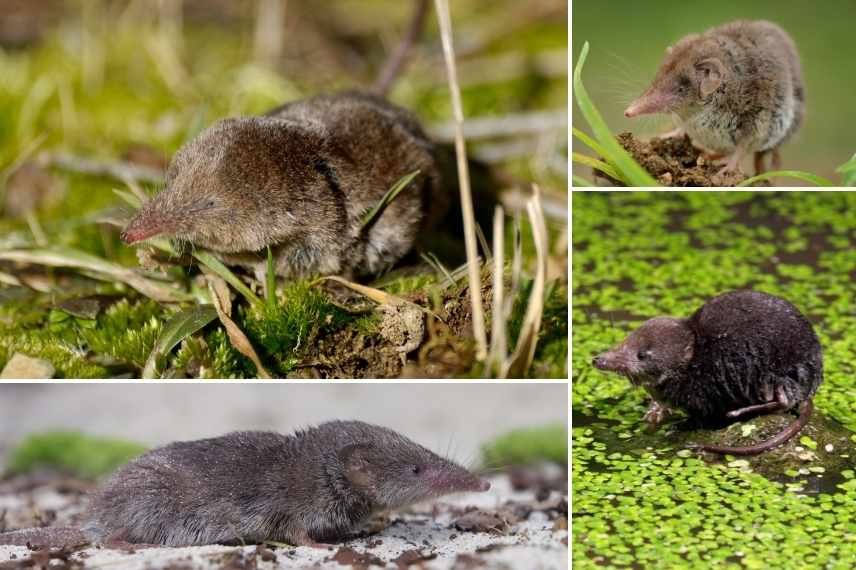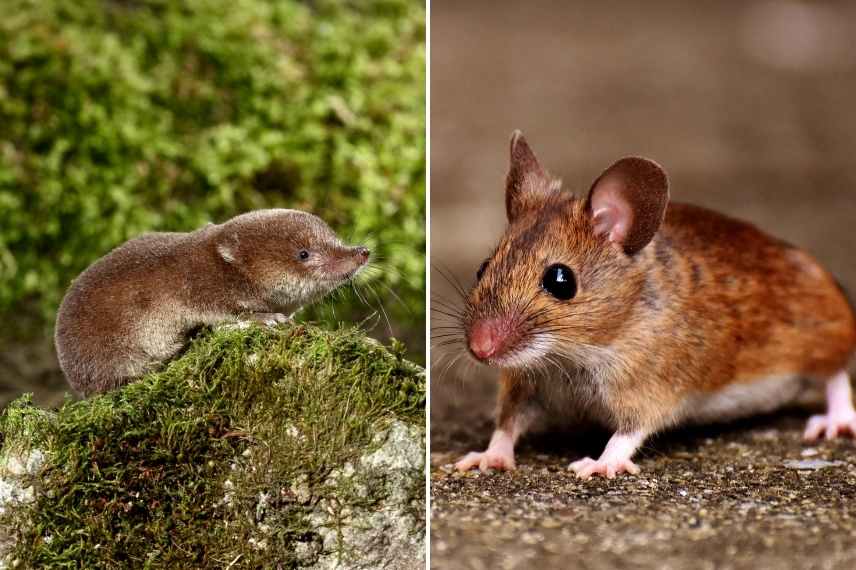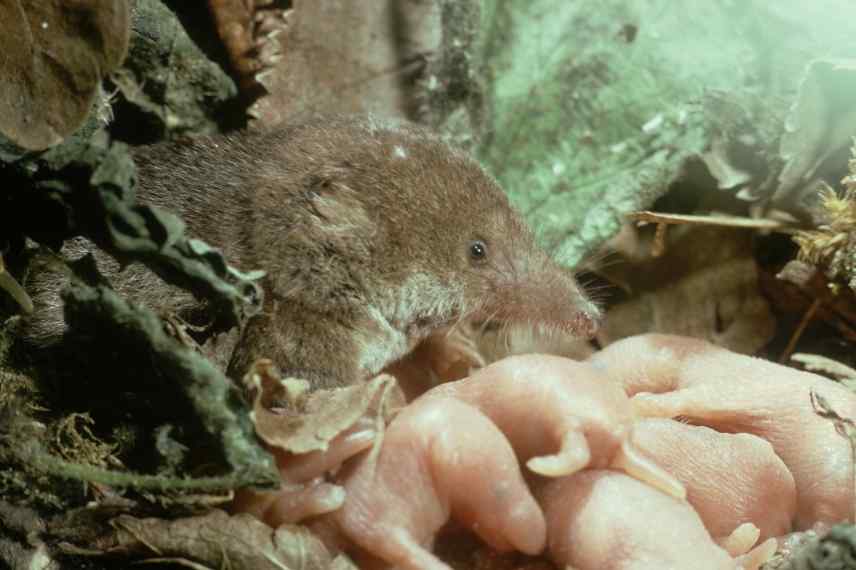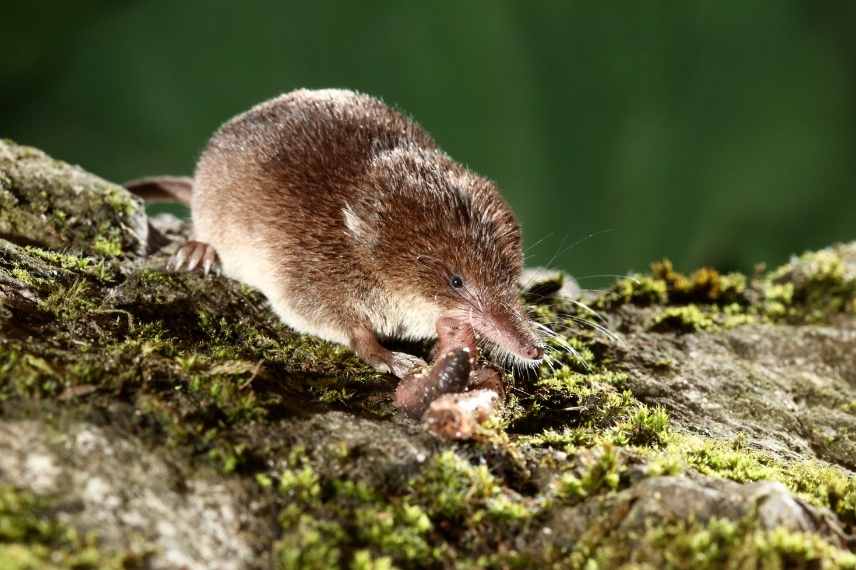
Garden Helper: The Shrew
A friendly ally for the gardener
Contents
Shrews are very small mammals whose exclusively insectivorous diet is a blessing for gardeners. Formidable and insatiable garden allies, shrews, the most common of which is the Common Shrew or Eurasian Shrew, delight in pest insects, larvae, parasitic organisms, as well as slugs and snails. The shrew is not a rodent and does not consume fruits, vegetables, or flowers. So let’s make a lovely space in our gardens for these charming little creatures!
How to recognise a shrew?
The name “shrew” is a vernacular name that is often confusing, as it encompasses many small mammals from different genera (370 species in total worldwide). Here, in France and Belgium, only 6 species from the family Soricidae are referred to as “shrew”:
- The Common Shrew or Eurasian Shrew (Sorex areneus): quite common in the northern part of France and in Belgium. It lives more underground than other shrews;
- The Crowned Shrew (Sorex coronatus): typically found at higher altitudes;
- The Water Shrew (Neomys fodiens): found in wet areas;
- The Eurasian Water Shrew (Crocidura russula);
- The Field Shrew (Crocidura leucodon);
- The Garden Shrew (Crocidura suaveolens)
 From top left to bottom right: Common Shrew, Garden Shrew, Eurasian Water Shrew, and Water Shrew
From top left to bottom right: Common Shrew, Garden Shrew, Eurasian Water Shrew, and Water Shrew
The Eurasian Shrew or Common Shrew is the most frequently encountered in our gardens. A shrew measures up to about ten centimetres. Size varies by species. It has small eyes, an elongated and very mobile snout, a short and hairless tail, and a silky, fairly short, brown-grey coat with a reddish tint.
Shrews are not mice and are not rodents. Their teeth do not grow continuously like those of rodents, but stop growing at a certain point and wear down over time. This is probably one of the reasons for the relatively short lifespan of shrews (18 months for the Common Shrew).
The differences from a mouse do not stop there and are numerous:
- The snout of a shrew is fine and elongated, somewhat like a sort of trunk. It is very mobile and has many vibrissae (“sensory whiskers”);
- The tail of a shrew is relatively short, especially compared to that of a mouse or rat;
- The eyes are smaller, the ears more diminutive, and the legs shorter than those of a mouse;
- A shrew always appears stockier, a bit plump compared to mice;
- Finally, although it is harder to see when it scurries quickly between your feet, the forelegs of a shrew have 5 toes compared to 4 for a mouse.
 Common Shrew on the left and Mouse on the right
Common Shrew on the left and Mouse on the right
Did you know?: the word “shrew” comes from the Latin “mus” for “mouse” and “araneus” for “spider”. Indeed, it was once believed that the shrew was venomous. This is only true for a few exotic species, and their venom is only effective against their prey. No need to worry for us bipedal beings!
Read also
Toad, a useful animal to preserveThe life of a shrew
Rather solitary, the female and male shrews only meet during the breeding season: between March and autumn. A female shrew can have 5 litters a year of 2 to 8 young after a gestation period of 20 days. This may seem like a lot, but infant mortality is quite significant. The young from the litter follow their mother in a line: holding onto the tail of the one in front with their teeth.
In our region (northern hemisphere), we only find species of shrews known as “red-toothed”, the colour being due to a high concentration of iron (which makes the teeth more resistant to wear). The species of shrews known as “white-toothed” are more tropical.
Weighing only a few grams, shrews do not remain inactive for more than two hours during the day.
A few hours without food will result in the animal’s death. This is why they search for food both day and night. Their heart rate can reach up to 1000 beats per minute.
A common shrew lives only about 18 months on average. Shrews have adopted a particular method to survive winter. They do not hibernate, but significantly reduce their food needs by “losing weight” dramatically: their organs decrease in weight and volume, their vertebrae and even their skull shrink. This phenomenon is called the Dehnel phenomenon.

A female shrew and her litter
The usefulness of the shrew for gardeners and in Nature
Predators
The Common Shrew or Eurasian Shrew has a highly developed sense of smell for hunting; it can detect its prey several dozen centimetres underground. It is a valuable ally for gardeners as a helper. Indeed, it can consume 2 to 3 times its own weight in a single day. It feeds on insects (caterpillars, beetles, earwigs…), spiders, larvae (including ticks!), slugs, snails, other small invertebrates, earthworms… and sometimes its own droppings. It eats day and night without really stopping. A few hours without food are enough to cause its death. Primarily insectivorous-carnivorous, shrews do not consume any fruits, vegetables, or flowers. The shrew actively helps to reduce the number of pests or parasites in the garden.
 The shrew must constantly be in search of food
The shrew must constantly be in search of food
Prey
The Common Shrew is hunted by several predators: owls (Barn Owl) and hawks, the Eurasian Kestrel, the Common Buzzard, the Red Fox, the European Weasel, the Marten, the Polecat, and the Stoat, some snakes (Asp Viper), fish (in the case of aquatic shrews), and even cats. Regarding the latter, our feline companions often just play with the shrew until it dies, usually disregarding the corpse afterwards due to its unbearable smell…
The decline of insects in our countryside reduces the populations of insectivores, including shrews, and consequently threatens the populations of natural predators, particularly diurnal and nocturnal raptors. “One being is missing and all is desolate…“
Did you know? Shrews are extremely sensitive mammals. The animal can literally die of fear.
What to do to welcome it to the garden?
Shrew populations tend to decline in number. The factors are the same as usual: the loss of natural habitats, environmental pollution, and the reckless use of insecticides over decades.
Fortunately, it doesn’t take much for your garden to become welcoming to these charming little creatures. Shrews appreciate in nature and the garden: wet, vegetated shores, bushes, dense hedges, and uncut tall herbs. This allows them to find shelter and food. Avoid slug pellets, any form of insecticidal (even so-called organic or natural ones!) and create a small pile of stones near the compost; shrews will spend the winter there and raise their young.
- Subscribe!
- Contents
































Comments